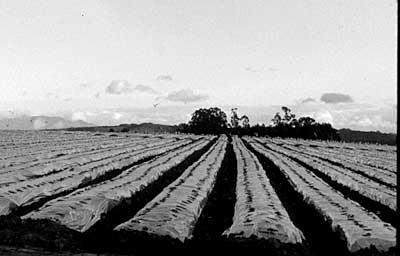Deadly chemicals applied in Moss Landing
October 2007
|

Death Rows. Telltale plastic covers fields treated with methyl bromide. Photo Debbie Bulger
|
On June 6, 2007, Steven Rodoni, owner and operator of Springfield Farms was granted a first time permit by the Monterey County Agricultural Commissioner, Eric Lauritzen, to spray 54 acres of farmland abutting Potrero Road in Moss Landing with a mixture of toxic and deadly restricted-use pesticides: Telone, Methyl bromide, and Chloropicrin.
Telone's material safety data sheet states: "easily attainable vapor concentrations may cause serious adverse effects, even death."
Methyl bromide is a potentially deadly chemical with the highest possible toxicity (Level 1) for acute inhalation, eye irritation, and skin irritation. It is a neurotoxic gas that can cause convulsions, coma, and long-term neuromuscular and cognitive deficits. Twenty deaths have been reported as a result of methyl bromide fumigation in California since 1985. Two of the victims died in their own homes by licensed applicators according to pesticide websites.
Chloropicrin's label states "poisonous liquid and vapor, inhalation may be fatal." All of these fumigants have been known to drift off the fields of application and into nearby residential communities.
The use of methyl bromide was scheduled to be banned in the United States in 2005 under the UN Montreal Protocol on Substances that Deplete the Ozone Layer. However, exemptions allow “critical uses” to continue. The fact that there is now a thriving organic strawberry industry on the Central Coast belies use of this toxic chemical for strawberry production.
The Moss Landing fumigation directly affects about 300 residents, many with young children, as well as habitat for extremely-sensitive migratory birds, rare coastal native plants and marine mammals. The residents were opposed to the fumigation, and California Rural Legal Assistance, Inc. (CRLA) with the help of Pesticide Action Network, and Californians for Pesticide Reform filed a lawsuit represented by Jonathan Gettleman of CRLA. The Ventana Chapter donated $1,000.
Gettleman argued that the fumigant labels, which provide directions and rules for use, are inadequate to protect human health and are based on outdated science. At first, Judge Susan M. Dauphine granted two injunctions and temporary restraining orders to prevent “great and irreparable injury from occurring” in the Moss Landing Heights Community from application of the pesticides. When the parties returned to court in early August, the judge did not extend the temporary restraining order. Fumigation started the following week and will consist of seven applications over three months.
The Community of Moss Landing continues to fight for the right to be free from exposure to highly-toxic, restricted-use pesticides. Springfield Farms has applied the chemical next to Potrero Road, forcing residents who live there to enter the restricted buffer zone of 100 feet to get to their homes.
According to CRLA, the judge has now refused two attempts by Moss Landing residents to obtain a preliminary injunction that would prevent pesticide applications while the case goes to trial. CRLA has been in contact with numerous experts and is currently gathering evidence for the trial. Pesticide drift has already been detected, and residents have been injured. CRLA has identified violations of federal law and the permit itself.
Should the residents of Moss Landing be forced to live in a constant state of fear from exposure to deadly pesticides? This question is especially important in cases like Moss Landing where the grower was motivated by profit to change his crop from artichokes to strawberries, which he claims requires these terrible chemicals.
To offer assistance, contact Jonathan Gettleman or Mike Meuter at CRLA, 3 Williams Road, Salinas, CA 95060. 757-5221.
< back to all issues
|

